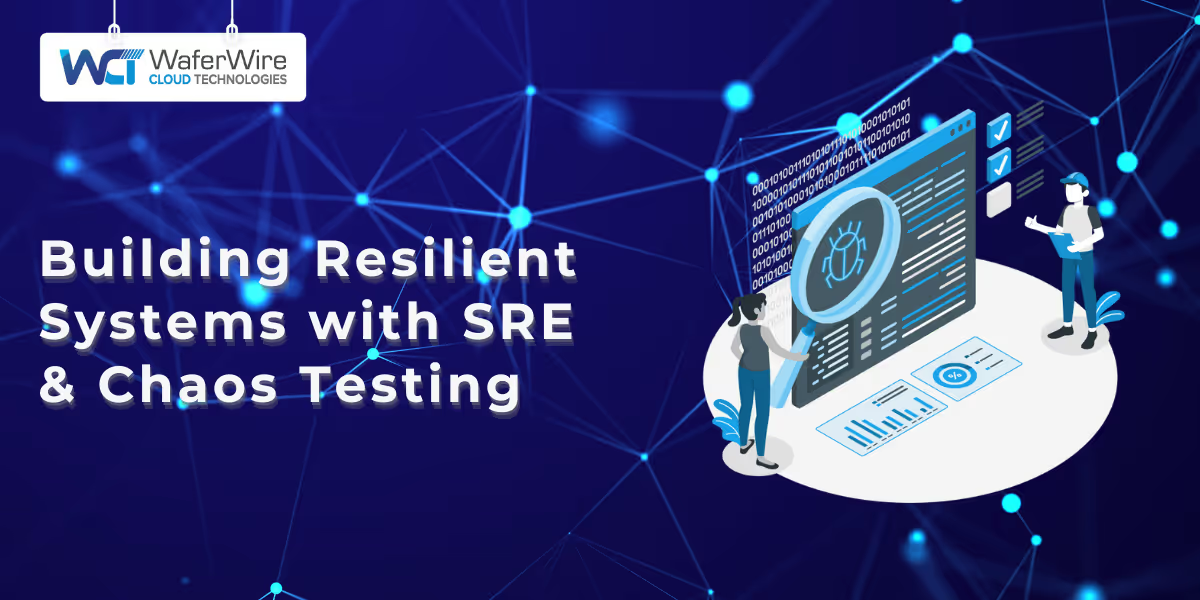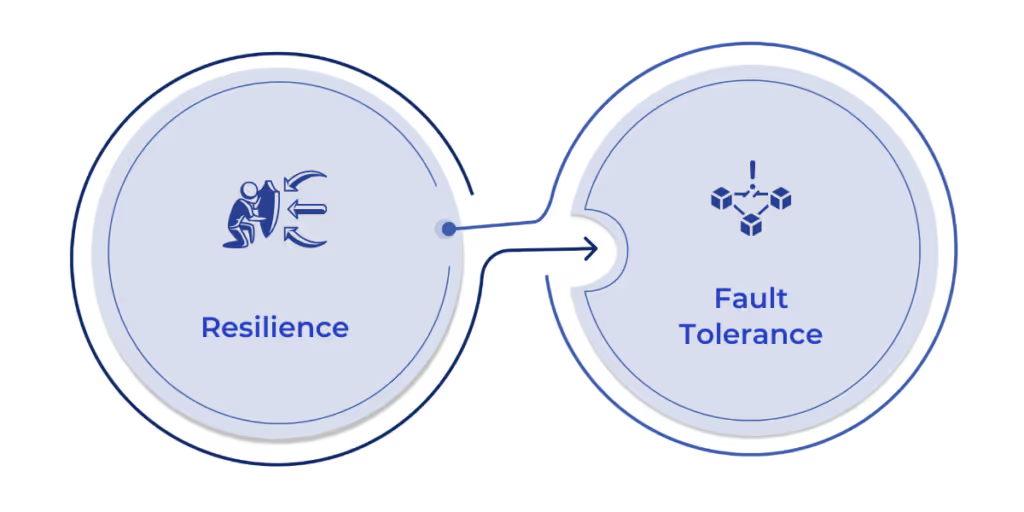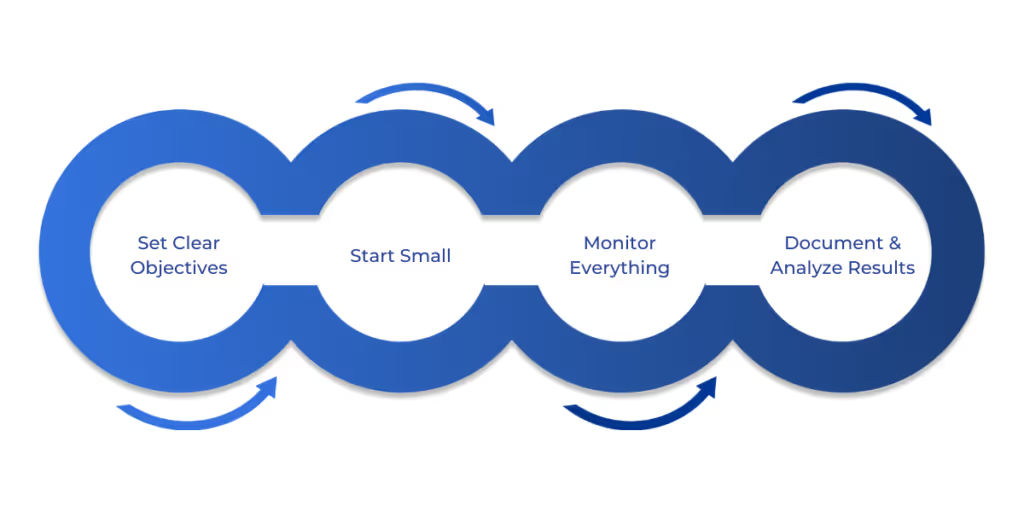

System failures are frequently unavoidable and have a huge financial impact on businesses, resulting in major revenue losses, reputational damage, and operational disruptions. In fact, 93% of enterprises report that downtime costs them over $300,000 per hour. Nearly half of these companies face losses exceeding $1 million for every hour of inactivity. Given these staggering figures, resiliency isn’t optional for companies that require high availability—it’s a fundamental necessity to ensure continuous operations and minimize financial risks.
SRE resilience testing ensures that systems are not just functional but capable of absorbing failures, recovering swiftly, and maintaining seamless performance under stress. Resilience isn’t a byproduct of good engineering—it’s a deliberate practice that involves identifying vulnerabilities, testing failure scenarios, and reinforcing recovery mechanisms.
Chaos testing takes this a step further by injecting controlled failures into live environments to expose weak points before real disruptions occur. Instead of reacting to outages, teams refine their systems through continuous failure simulations, making infrastructure stronger with every test.
This article explores how SRE resilience testing and chaos testing create fail-proof systems, ensuring reliability in an unpredictable world. When failure is a given, preparation makes all the difference.
Site Reliability Engineering (SRE) ensures that digital services run reliably, efficiently, and at scale. It combines software engineering with IT operations to automate reliability, reduce downtime, and improve system resilience.
SRE focuses on preventing failures before they impact users. Instead of reacting to outages, engineers build systems that predict, withstand, and recover from failures automatically. This is achieved through SRE resilience testing, where failures are simulated to measure system response and recovery times.
For example, a few seconds of downtime in financial services can disrupt transactions, while in manufacturing, an unstable system can halt entire production lines. SRE minimizes these risks by continuously monitoring system health, optimizing performance, and automating recovery processes.
SRE blends software engineering with IT operations to create self-healing, high-performing systems. Instead of waiting for failures, engineers anticipate, test, and eliminate risks before they disrupt business operations. This proactive approach prevents downtime and ensures a seamless experience for customers.
SREs use error budgets to decide how much risk is acceptable. For example, if a company aims for 99.95% availability, it means the system can be down for about 4.5 hours per year without exceeding the limit. Teams can continue rolling out new updates and features if the total downtime stays within this budget.
However, if downtime exceeds this limit, new deployments must be paused until the system’s reliability improves. This approach ensures that businesses can keep innovating without compromising stability.
Data-driven decisions set SRE apart from traditional IT operations. Engineers analyze historical failures, system logs, and performance metrics to predict potential risks. Using techniques like chaos testing and fault injection, they simulate real-world failures to measure how well a system can recover.
Without continuous testing, resilience is just a theory. SRE resilience testing ensures that every system component can handle failure, scale efficiently, and recover fast. Businesses that rely on manual testing or periodic checks increase their risk of unexpected failures.
Automated testing tools run stress tests, load simulations, and failover drills to identify weak points. Netflix’s Chaos Monkey, for instance, randomly shuts down production servers to force systems to adapt. This approach exposes weak spots before customers notice problems.
Building reliable systems isn’t just about monitoring. It’s about actively testing failure scenarios and ensuring systems bounce back. The next section covers the testing techniques SREs use to reduce downtime, improve recovery times, and strengthen resilience.
SRE resilience testing reduces guesswork by systematically testing every layer of the infrastructure before failures impact customers.
A highly available system is only as strong as its weakest component. Unit testing ensures every function works as expected before interacting with other system parts. Without it, minor defects can snowball into major outages.
SREs focus on test coverage, ensuring that individual units and dependencies, integrations, and failure scenarios are validated. A system with high test coverage is less likely to fail under unpredictable conditions. However, coverage alone isn’t enough; tests must also account for real-world user behavior, load conditions, and unexpected inputs to be truly effective.
Failures are inevitable, but how quickly they are detected and resolved makes the difference. Mean Time to Recovery (MTTR) is a key metric in SRE resilience testing, measuring how long a system takes to restore normal operations after a failure.
SREs rely on real-time monitoring, alerting, and automated diagnostics to detect issues before customers even notice them. Leading enterprises use observability tools like Prometheus, Grafana, and Datadog to track latency, resource consumption, and error rates. Faster detection means faster recovery, ensuring minimum disruption to critical services.
Some failures should never reach production. Zero MTTR bugs—critical defects that require instant recovery with zero downtime—are handled through automated rollbacks, canary deployments, and self-healing mechanisms.
For example, in financial services, even a millisecond delay in transaction processing can impact thousands of users. SREs implement feature flags, automated failovers, and containerized deployments to revert to stable versions instantly if an issue is detected. This ensures that critical services remain unaffected, even when unexpected failures occur.
Failures do not necessarily follow a script. Even with extensive testing, unexpected outages do occur. Chaos testing extends resilience by purposefully creating failures to ensure systems can recover without breaking.
Next, we'll look at how chaos testing improves dependability and reduces downtime.
No system is failure-proof. The real challenge is how well it can survive chaos. Traditional testing ensures software works under expected conditions, but real-world failures are rarely predictable. Servers crash, dependencies break, and sudden traffic surges can overwhelm even the most robust systems. SRE resilience testing isn’t complete without chaos testing, which deliberately introduces controlled failures to evaluate recovery speed, stability, and fault tolerance.
Chaos testing, also known as chaos engineering, started at Netflix when engineers realized that traditional testing could not predict failures in live environments. They created Chaos Monkey, a tool that randomly shuts down servers to see if their infrastructure can handle failures without downtime. The idea is simple: break things before they break on their own.
Today, chaos testing is used by enterprises across industries to ensure that their systems remain stable even when critical components fail. Retailers use it to test whether payment gateways can handle failures. Financial institutions apply it to validate if transactions can continue during server crashes. Manufacturing companies rely on it to confirm that their automated processes don’t stall due to infrastructure issues.
AspectTraditional SoftwareChaos TestingObjectiveEnsures software functions correctly under expected conditionsEvaluates system resilience by simulating unexpected failuresTesting EnvironmentControlled environments (staging, QA)Live or production-like environmentsFailure HandlingIdentifies and fixes bugs before deploymentIntentionally disrupts components to test recovery mechanismsPredictabilityHighly predictable, follows predefined test casesUnpredictable, introduces random failuresFocus AreaFunctionality and expected behaviorSystem stability and fault toleranceEnd GoalDetect and fix defects before releaseBuild self-healing systems that recover without human intervention

Chaos testing is about building resilience. A resilient system doesn’t just function when everything is perfect; it adapts, recovers, and continues operating even when critical failures occur.
A resilient system can lose a node, a server, or an entire region and still keep running. Chaos testing ensures that failures don’t turn into outages, helping businesses stay online no matter what. By intentionally introducing disruptions, chaos testing strengthens systems and makes them more adaptable to real-world failures.
Next, we’ll explain how to implement chaos testing effectively, from designing failure scenarios to analyzing results that drive real improvements.
Chaos testing helps businesses build resilience by intentionally introducing controlled disruptions and measuring their impact. This structured approach ensures that failures occur in a controlled, measurable way rather than unexpectedly in production.
Chaos testing follows a clear, four-step process to simulate failures and analyze system behavior:
Chaos testing isn’t one-size-fits-all. It varies based on business needs and infrastructure complexity. Here are some common approaches:
Each type of experiment reveals different weaknesses in a system, allowing engineers to harden infrastructure before real failures occur.
Netflix transformed chaos testing from an idea into a real-world resilience strategy. Their Chaos Monkey tool randomly terminates production servers to ensure the system can handle failures seamlessly. This forced Netflix to build systems that self-heal, reroute traffic, and maintain uptime—even when entire servers go down.
Today, many enterprises use chaos engineering tools inspired by Netflix’s approach. Businesses apply similar strategies to protect their critical services from unexpected outages.
Conducting chaos tests is just one aspect. Choosing appropriate tools and adhering to best practices guarantees that tests are secure, significant, and lead to genuine enhancements. Let's explore this further.
Chaos testing without the right tools is like stress-testing a bridge without measuring its strength. To make failure experiments meaningful, engineers rely on specialized tools that inject controlled disruptions, monitor system behavior, and provide actionable insights.
Several tools help businesses implement SRE resilience testing effectively:

Running chaos tests requires a controlled, strategic approach to avoid unintended disruptions:
While chaos testing is powerful, it comes with complexities:
Despite these challenges, businesses that embrace chaos testing see fewer outages, faster recoveries, and stronger system resilience.
Next, we’ll examine the real-world benefits of SRE resilience testing and chaos testing and the key challenges businesses must overcome.
Preventing failures is impossible, but minimizing their impact is a choice. Businesses that embrace SRE resilience testing and chaos testing don’t just reduce downtime—they build systems that can self-recover, adapt, and perform under any condition.
A resilient system doesn’t just bounce back from failures—it keeps running even when things go wrong. SRE and chaos testing ensure that:
Testing for failures before they happen reduces unexpected incidents in production. Chaos testing helps engineers:
Despite the benefits, chaos testing comes with operational challenges:
Testing focuses on creating strong and reliable systems even when failures occur, moving the emphasis from simply preventing errors to surviving in the face of them. SRE resilience testing and chaos engineering have transformed how businesses approach dependability, making downtime predictable, recovery faster, and risks easier to manage.
Businesses that rely on assumptions struggle when issues arise. Proactively testing, refining, and upgrading systems minimizes disruptions while offering a competitive edge. This goes beyond mere technology; it involves safeguarding revenue, maintaining consumer trust, and ensuring business continuity.
At WaferWire, we engineer reliability, not just fix failures. Our expertise in SRE resilience testing, chaos engineering, and proactive optimization helps enterprises build infrastructure that doesn’t just survive outages—but powers through them with zero disruption.

